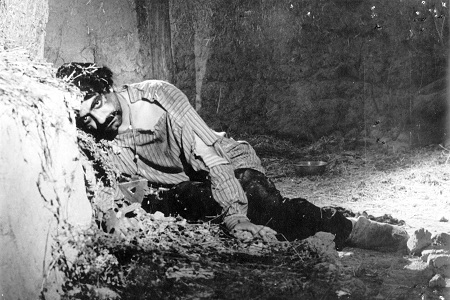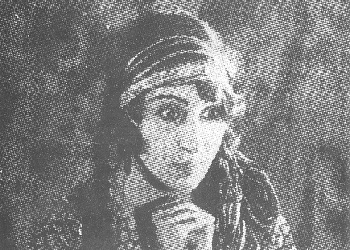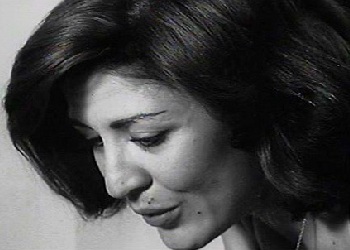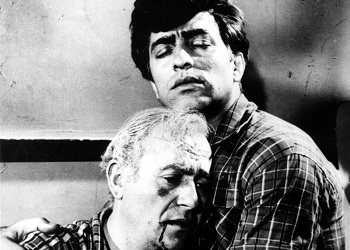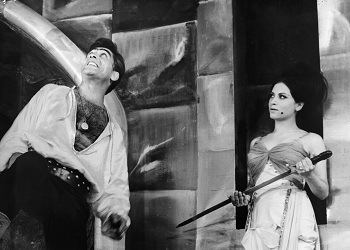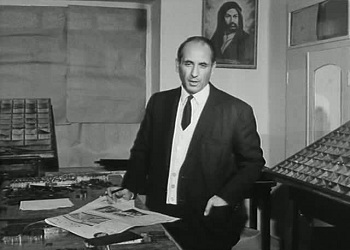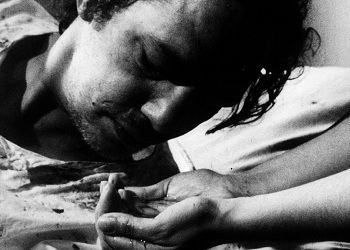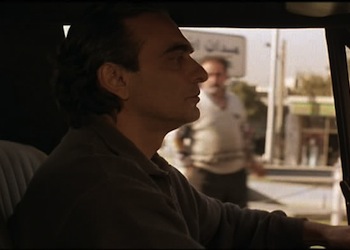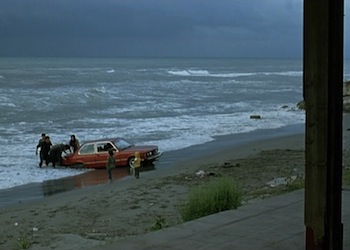Translated by Ehsan Khoshbakht; photos courtesy Film Monthly.
Translator’s note: Houshang Golmakani is the editor-in-chief of the Iranian Film Monthly, the first post-revolution film journal in Iran which, amazingly, has survived for 30 years. Aside from his full-time presence in the office of Film Monthly in downtown Tehran, he has written books on Iranian cinema and directed Stardust Stricken (1996) about Mohsen Makhmalbaf.
This list doesn’t necessarily represent the monuments of Iranian art-house cinema, but it is something of a map for those curious cinephiles who want to know more about Iran’s cinema and its unique film industry. It is important to know that Iranian national cinema is not limited to names like Kiarostami, Makhmalbaf or Panahi. Aside from the work of great filmmakers with artistic ambitions since 1960s, there are certain kinds of commercial films that deserve attention, especially considering the fact that some of them present the “national genres” at their best. So let’s say this: here are 50 films that are essential to understanding Iranian cinema.
1. Haji Agha, the Cinema Actor (Ovanes Oanian, 1933): Ironically, the earliest surviving Iranian film is a witty commentary on Muslims by an Iranian Armenian. This silent answer to The Jazz Singer also foresees the future of problems and misunderstandings faced by Iranian cinema.
2. The Lor Girl (Ardeshir Irani, 1933): The first Iranian talkie is moody propaganda with a cliffhanger.
3. The Stumble (Mehdi Rais-Firouz, 1953): A popular melodrama with a straightforward moral message.
4. The Swallows Return to their Nest (Majid Mohseni, 1964): The most successful film of a national genre, a villagers’ film which can be compared to the Soviet Union farmer films, or the pastorals of French cinema.
5. The Brick and the Mirror (Ebrahim Golestan, 1965): Probably Iran’s first art-house film, and definitely the first serious attempt to use the medium of cinema as an expressive tool. One of the few films of its period that has remained worthy of attention and rediscovery.
6. The Strike (Samuel Khachikian, 1964): A western-influenced crime film made by the Iranian Hitchcock and one of so many Armenians involved in Iran’s film industry.
7. The Night of the Hunchback (Farokh Ghafari, 1965): A burlesque and a lively, modern adaptation of 1001 Nights by one of the founders of the Iranian cinematheque and a close friend of Henri Langlois.
8. Croesus’ Treasure (Syamak Yasami, 1965): Offers an extremely popular message of reconciliation between social classes while bringing escapist entertainment to the impoverished; it also brings the popular song and dance of the Tehran’s cabarets to the screen.
9. Amir Arsalan-e Namdar (Esmail Kushan, 1966): An historical costume drama based on a piece of famous folklore whose paperboards sets, awful make up and campy costuming turn it into a parody of the 1001 Nights’ fad.
10. The Night It Rained (Kamran Shirdel, 1967): The best documentary in the history of Iranian cinema with virulent humor about another piece of nonfiction filmmaking, a documentary that was never made. Echoes of Rashomon.
11. Gheisar (Massud Kimiai, 1969): A turning point in the history of Iranian cinema and one which anticipates the political changes of the following decade through a story of vengeance.
12. The Cow (Dariush Mehrjui, 1969): The first serious attempt to bring Iranian modern literature to the screen and a major example of the New Wave—Iranian style.
13. Tranquility in the Presence of Others (Naser Taghvai, 1969): This film, along with Gheisar and The Cow, changed the history of Iranian cinema in the new decade whose last year ended in a revolution. It was banned until 1971.
14. Dancer of City (Shapur Gharib, 1970): Another popular pre-revolution genre was the “Jaheli film,” about the tough guys, hoodlums and the thugs in the neighborhood who usually fall in love with prostitutes and save them at the end, though it never comes easy and splashing some blood on screen seems inevitable.
15. Reza Chelcheleh (Mehdi Mirsamadzadeh, 1971): A vaudeville variety show with the kind of happy-go-lucky people still present in Iranian films to this day. The fact that it was made by an Institut des Hautes Études Cinematographiques graduate only adds to the many surprises to be found in Iranian films.
16. The Carriage Driver (Nosratallah Karimi, 1971): Neo-realism, Iranian style.
17. Kako (Shapur Gharib, 1971): Features old-time heroes who have no place in the changing society. Sounds like Peckinpah, but it’s very Iranian indeed.
18. The Morning of the Fourth Day (Kamran Shirdel, 1972): Remake of À bout de soufflé.
19. Mehdi Meshki and Hot Pants (Nesame Fatemi, 1972): Another comic entry to the “Jaheli films” genre, only this time the focus is on the conflict and accordance between tradition and modernity—the old hero meets a western woman in hot pants! It cannot get clearer than this.
20. Tangna /Deadlock (Amir Naderi, 1973): Iranian social drama with a noir flair.
21. The Mongols (Parviz Kimiavi, 1973): Iran embraces the avant-garde.
22. The Deer (Massud Kimiai, 1976): The greatest artistic achievement of one of the pioneers of the Iranian New Wave and a monument in Iranian cinema. It is no wonder that Iranian film critics have selected this film as the greatest film in in the history of Iranian cinema.
23. Samad Goes Artist (Parviz Sayyad, 1974): A “Mr. Simpleton” from a small village in Iran offers vulgar jokes that are not devoid of social and political critique.
24. Stranger and the Fog (Bahram Beizai, 1976): Heavy political symbolism, wrapped in complex mythical symbolism.
25. Still Life (Sohrab Shahid-Saless, 1974): Shahid-Saless, a master of depicting daily life in its plain, unadorned form, gives haunting, sad beauty to the dead moments of life.
26. Beehive (Fereydun Gole, 1975): Hell is the city; reminiscent of The Swimmer, while the pool has changed into bar.
27. Desiderium (Ali Hatami, 1978): A poetic piece about the past, told as a love story between a mentally impaired man and a prostitute. Shohreh Aghdashloo, the actor who portrays the prostitute, moves to the United States after the revolution, and later gets nominated for an Oscar for House of Sand and Fog.
28. Hajji Washington (Ali Hatami, 1982): Another nostalgic reminiscence of the past which its lyrical aspects were never understood at the time of the initial release. Probably because everybody was too busy with “more important things” in the revolutionary country.
29. Bashu, the Little Stranger (Bahram Beizai, 1990): War, peace and metaphoric cinema.
30. Hamoun (Dariush Mehrjui, 1990): Mehrjui sends the Iranian male intellectual on a journey of doubt and despair in which nods to Fellini and Woody Allen are vital.
31. Nassereddin Shah, the Cinema Actor (Mohsen Makhmalbaf, 1992): A compassionate tale, told by a rebel from Iranian cinema, and loaded with political allusions.
32. Life and Nothing More… (Abbas Kiarostami, 1992): A new look at something that everybody thought didn’t deserve a new look. The result? Rediscovering reality with a touch of poesy.
33. Redhat and Cousin (Iraj Tahmasb, 1994): A puppet movie with two sweet and popular characters that broke all box-office records.
34. The White Balloon (Jafar Panahi, 1995): Discovering and masterfully depicting the drama of everyday life. The birth of a new auteur.
35. Journey to Chazabeh (Rasool Mollagholi Poor, 1995): A good example of another specifically Iranian genre: the mystical war film.
36. Taste of Cherry (Abbas Kiarostami, 1997): A film about suspense in everyday life, which brought a Palme d’Or to its genuine auteur.
37. Children of Heaven (Majid Majidi, 1997): Isn’t it amazing that Majidi uses “poverty” to “enrich” his filmic aesthetics?
38. To Be or Not to Be (Kianoush Ayari, 1998): The essence of reality, both in content and style.
39. Ten (Abbas Kiarostami, 2002): A revolution in narrative, done entirely in a moving car in the streets of Tehran, but by no means done simply or hastily.
40. Color Purple (Ebrahim Hatamikia, 2004): An Iranian political thriller; Sidney Lumet style.
41. The Lizard (Kamal Tabrizi, 2004): A transgressive comedy that crossed one of the red lines of the Islamic Republic: joking about mullahs. The story is a remake, more or less, of We’re No Angels.
42. The Fish Fall in Love (Ali Rafie, 2006): The Iranian theater maestro fulfills an old dream and makes his first feature film. To us, it felt like when Peter Brook went behind the camera for the first time.
43. Ashkan, the Charmed Ring and Other Stories (Shahram Mokri, 2009): If you want to see what the films of young, contemporary Iranian filmmakers look like, watch this.
44. About Elly (Asghar Farhadi, 2009): A giant is born. You cannot find a better cinematic representation of lives of the young Iranian middle class.
45. Salve (Alireza Davoudnejad, 2010): This film proves that Iranian cinema’s most powerful weapon is still realism.
46. A Separation (Asghar Farhadi, 2011): This straight masterpiece divided Iranian cinema into two periods: before A Separation and after A Separation.
47. A Cube of Sugar (Reza Mir-Karimi, 2011): Longing for an Iranian Belle Époque.
48. Absolutely Tame Is a Horse (Abdolreza Kahani, 2011): Purely absurd and utterly insane.
49. Here Without Me (Bahram Tavakoli, 2011): A lively Tennessee Williams adaptation, set in contemporary Iran.
50. Stories (Rakhshan Bani-E’temad, 2012): Bani-E’temad, one of the best female filmmakers in the country, follows the story of her films’ characters after nearly two decades. Socially conscious and bitter, without losing continuity.

